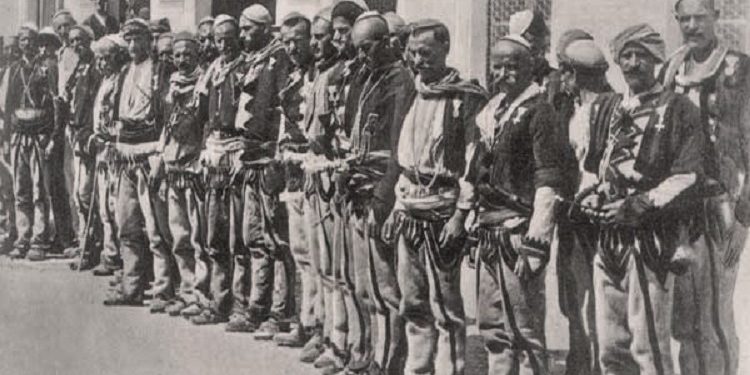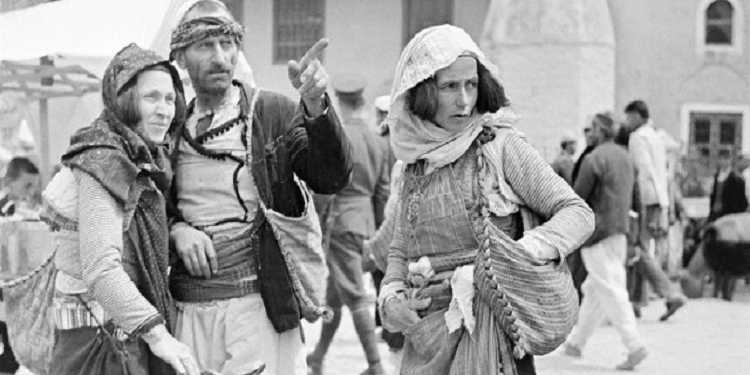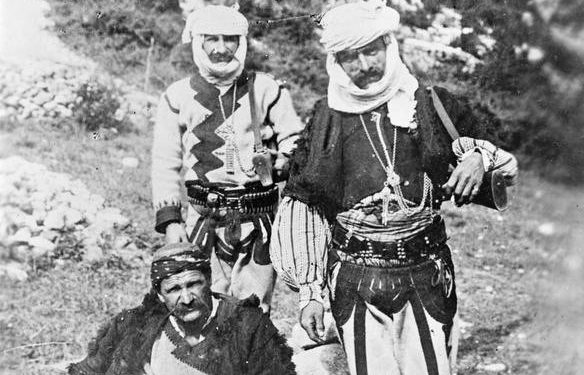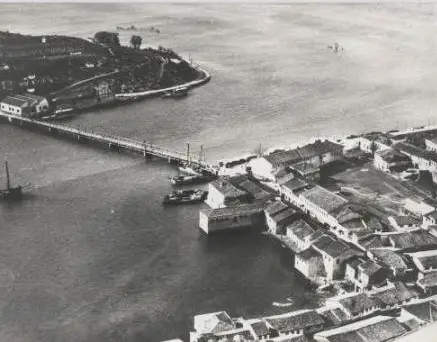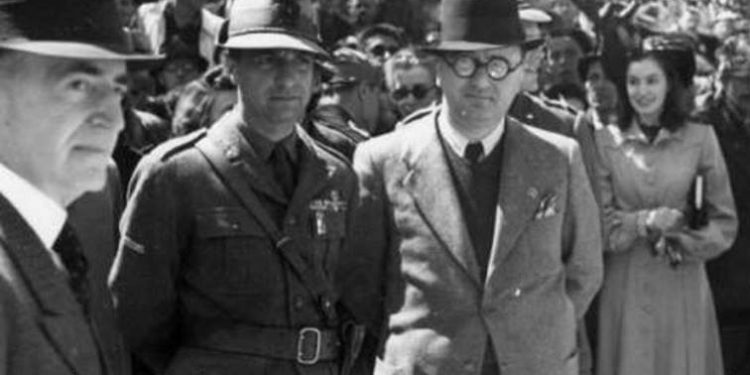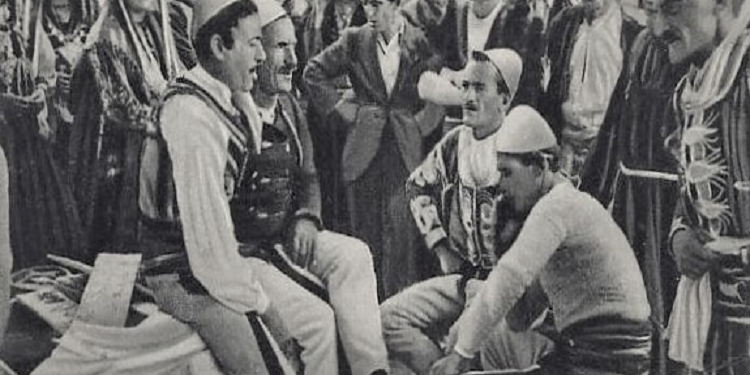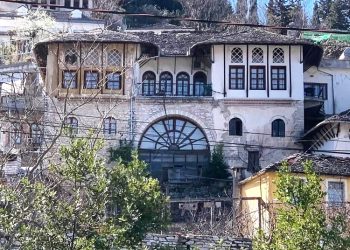By Sven Aurén
Translated by Adil N. Bicaku
Part twenty-four
ORIENTI EUROPE
Land of Albania! Let me bend my eyes
On thee, thou rugged nurse of savage men.
Lord Byron.
In the book “Orient of Europe”, the author of the work is the Swede Sven Aurén. They are impressions of traveling from Albania from the ‘30s. His direct experiences without any retouching.
In a word, the translation of the book will bring to the Albanian reader, the original value of knowing that story that we have not known and we continue to know it, and now distorted by the interests of the moment.
Now a little about what these lines address to you: My name is Adil Bicaku. I have worked and lived for over 50 years in Sweden, without detaching for a moment, the thought and feeling from our Albania.
I am now retired and living with my wife and children, here in Stockholm. Having been for a long time, from the evolution of the Albanian language, which naturally happened during these decades, I am aware of the difficulties, not small, that I will face, to give the Albanian reader, the experiences of the original.
Therefore, I would be very grateful if we could find a practical way of cooperation together, to translate this book with multifaceted values.
Morally, I would feel very relieved, paying off part of the debt that all of us Albanians owe to our Albania, especially in these times that continue to be so turbulent.
With much respect
Adil Biçaku
Continued from the previous issue
THE STRIKE SHAKES TOWARDS NORTH
Its population is given up to 30,000, but it is believed that before it was much larger. The city is in fact a ruined grandeur. During the time of Turkey, Shkodra functioned as the capital of the Albanian province and played a very large economic role. But despite his diligent efforts, Shkodra failed to play the role of the capital of the Monarchy. Shkodra was degraded into a very ordinary Albanian city. King Zog settled in Tirana.
The inhabitants of Shkodra, have never really managed to chew this choice of city of residence and feel a considerable envy, on that situation, that Shkodra, as degraded as it is, but in fact gives a more impressive impression and western, than the official capital. Shkodra has many of the things that Tirana does not have: a boulevard surrounded by houses, really city-level, some great cafes, French-Austrian style, and an excellent and beautiful seaside promenade. Even in terms of the oriental, Shkodra is superior to Tirana. In Shkodra is located the largest and most important bazaar in Albania.
When it comes to traditions, Shkodra is an aristocracy, which despises the newborn Tirana. In ancient times, Shkodra was called ‘Scodra’ and the great lake Labeatis and here once in the world, had the residence of the Illyrian King, Genc. In 168 BC, the city was conquered by the Romans, under the leadership of Ankikius and Caesar Diocletian, designated it as the capital of the province of Prevalia. In 395 e.r.e., it became the property of Byzantium, and thus followed a period under the regime of the South Slavs, then the Venetians bought the city from a Montenegrin prince and erected various fortifications and ruins of which, are still located. Later came the Turks and then chaos.
And later Shkodra finally becomes Albanian again, which it has not been since the time of King Genc. Based on the interesting history, it seems that the archeological speculations of the authorities are quite grounded. Why cannot Shkodra offer opportunities for an archaeological expedition? The question arises in Tirana and shows the fact that the city has never been an object for some desired archaeological studies. Like many other Albanian cities, whose name is mentioned very often by historians of antiquity?
But it will be with excavations, which will enable the discovery of some important historical and artistic objects in Shkodra. The eye of the outsider catches nothing in this direction. The city has endured so many invasions, so many times desolation, and fire and looting, that nothing is left of the historical monuments. Romans, Turks, Montenegrins, Serbs, Venetians, and Austrians, all have many sins. That construction, which is today’s Shkodra, is not old. It comes mainly from the 1800s, with one or two insignificant elements, from the houses of the one thousand and seven hundred years, which were fortunate enough to survive all that destruction.
An old Turkish mosque, with its gardens and domes, gives associations with Constantinople, which belongs to the most interesting buildings to see. But unfortunately even that is on the way to extinction. It is located in the corner of the city and very close to the lake. Every autumn it is flooded with water, it enters the house of Allah and climbs upwards, to the beautiful walls of ceramic tiles and the stairs of the Imam, it is only a matter of time before the old mosque collapses completely.
The floods have had, at least indirectly, devastating consequences in another respect as well. When the lake water level returns to normal, a large number of water holes remain, in which mosquitoes grow and multiply. Just a few decades ago, this whole part of town was infected with malaria. But thanks to the energetic work of the Rockefeller Institute, mosquito outbreaks have been able to disrupt them to a large extent, and the control company recently provided us with a report on the number of children infected with malaria. , has dropped from 40 percent, to 8.
It is very strange that only this part of the city is at risk of malaria. The rest of Shkodra is, in all respects, a healthy place, with a clean and pleasant air. Besides, in the high summer season a cool city, which at least for the foreigner, has a lot of meaning. But when I say, that the eye of the stranger catches nothing, from the memories of times past, I can see how my literary guide takes a look of displeasure in the eye.
Ruins of castles on top of Rozafat! It is true: the great castle in Rozafat, deserves to be mentioned. Rozafat is one of the many mountains that surround Shkodra and on top of them; there are large gray walls, which are still left of the castle, important of that time. It was the Venetians who built this fortress and then the many lords of the city, who erected and improved which in turn.
In the 1870s, this served for the Turks, as one of the strongest acts of defense. But whoever has been the ruler of the castle, this has always fulfilled a dual function: it has served to keep the invaders away and to keep the inhabitants of Shkodra in chess, who have always surprisingly found it difficult, to forget their Albanian nationality.
But now this giant castle no longer houses any highly armed garrisons. It is nothing but a giant with a chaotic pile of stones, where the garrison has been replaced by thousands and birds. He, who believes that this chaos of stones is the result of an enemy attack victory, makes a big mistake. The collapse of the castle is related to completely different and much more tragic-comic causes. You could say its Benjamin Franklin’s fault that Rozafat’s castle is just a pile of rubble and nothing more.
The governor, who resided in 1874, in Shkodra had left the circle of zealous reformers, the young Turks. As a young Turk, he thought it’s his duty, in one form or another, to leave a practical testimony, of his love of reform, and as if he had heard, that a Franklin beacon, for approximately, a hundred years before, had invented a device with which you can, to deflect the devastating lightning strikes, so he decided to put such a device into use in Shkodra as well.
But the governor regretted, to some degree, for his decision, when he received the data, how much a lightning rod cost. Like most of his colleagues in the Turkish administration, he was really a saver. But he calculated that he could make a compromise: he would be content with the iron rod and the yellow ball. In the governor’s opinion, of course that part of the lightning rod that connected the rod to the roof with the ground was completely unnecessary.
Now all that remained was to find a suitable place for the first lightning rod of Shkodra. The governor thought here and there and decided thus, that the apparatus would be placed in that high castle, with the magnificent position, more precisely on the roof of the ammunition depot said done. In the interest of participants from all over the city, the lightning rod was mounted in the place designated by the governor. The young Turks cheered, the old Turks shook their heads in suspicion, the soldiers shouted: Long lives our Turkish governor!
Behind her waited the reform-loving governor, eagerly for the storm to break out, but delayed three weeks, until his wish was granted. But then it really came true. From the window of his Palace in Shkodra, he could see the threatening dark clouds floating on the top of Rozafat. Suddenly lightning, as well as once, and at that very moment, the governor saw how lightning was absorbed by that elegant lightning rod.
When the inhabitants of Shkodra, after the weather calmed down, thousands flocked up to the castle, they still had deaf ears. But they could see that what was left undamaged by the Sultan’s magnificent castle could be of no use. Those of the Turks, gathered outside the Governor’s Palace, took such a threatening position, and the great reformer ordered the suitcases ready. Those who were Albanian reacted differently. They fell on their knees and bowed their heads from Makkah, praising Allah, for His goodness, and Benjamin Franklin, for his invention.
No effective measures were ever taken to repair what was once such an important castle! Around the end of the century, the money of the Turkish state treasury began to run out. It seemed even more difficult to collect taxes from Albanian citizens, who understood the weak position of the Turkish state. Rozafat Castle remained ruin. Instead, they aimed to reinforce another mountain in Shkodra, the famous Tarabosh, which stretches along the southern flank of Lake Shkodra.
In Tarabosh, the artillery had an excellent position and it was this mountain, which caused King Nicholas the greatest trouble, during the siege of 1912-1913. Even in the Kingdom of Albania, Taraboshi always fulfills an important military function. In addition to its strategic value for King Zog personally, it has been important. The view from Taraboshi, is one of the most beautiful in Europe and this circumstance, the King has exploited to build a villa for himself, on the mountain slope.
Under the energetic direction of Koliqi, I paid a visit to the Royal Residence and was very impressed by the expensive terraces and beautiful rooms. In that case, the rooms were empty and groups of workers were removing velvet upholstery and the floor. The King’s architect had not properly understood his work. The humidity was making the builders’ work useless.
I mentioned that Shkodra makes an impression as more modern, more civic than Tirana. For a short period, 1913-1914, Shkodra was an extremely continental city. After Nikola was forced to take the road and the superpowers, together they took over the administration of Shkodra, so German, English, French, Austrian and Italian troops stormed inside the city, which was divided into a number of different regions. The Albanian mountain town suddenly became an international metropolis.
It became so international that the names of the streets were changed and the perverted people of Shkodra were faced with the newly painted street signs such as: “Rue Edouard VII”, “Rue Leipzig”, “Rue Garibaldi”. But during the strict neutrality, squares and open places were given names of a more general nature and pleasing to all parties. Soldiers from five countries marched on the Place des Marins and the Place des cinq Nacions. But so did the Sarajevo catastrophe, with the waves of the river of national suffering. The joint army in Shkodra turned into hostility, hatred and chaos.
***
From the old velvet sofas, the hotel café and the heavens of condensed tobacco smoke, we go out to the main street of Shkodra, which is the Albanian boulevard, which deserves the name boulevard. Here the wide sidewalks are surrounded by regular stone houses, large shops, rows of green and tall trees. Here a pet European feels like he is in a real city. Colic notices the impressions on the expression of our faces and gives me, a very meaningful look. It is not true; Shkodra should have been the capital of the country! Says this look.
To start simply from the prestigious look he is right. But he also knows (even though he is an ardent local patriot, he would never accept it) that King Zog was not able to pursue some aesthetic motives. The monarchy was not born at a time when there was time in Albania to think about aesthetics. Our friend whispers suddenly, and a magnificent cart, stands near the sidewalk corner.
-How is it possible that there are so few people? I asked as we walked down the street, where two officers made up the total public on the street. That there are exactly two officers, in fact, is not surprising. From the Albanian citizens, the officers are the ones who have a lot of time for walking.
– It is a shopping day, says Koliqi. All the people have gone shopping. We will go there too. Go faster, coachman! The man up in the armchair beats the weak animal with the whip. The boulevard ends at a long coastal promenade and there, where the small bridge over Buna, connects Shkodra with the Tarabosh hills, I see the pile of the bazaar building, rising high above the ground. Shkodra Bazaar is the largest in Albania. It comprises approximately 2,000 market stalls and is a stand-alone city. An oriental cigar town. The short trip from our hotel, to this bazaar place, is a road between the west and the east.
Even the city of the bazaar, has a main street, or rather, consists mainly of one: a very long and very narrow street, here and there intersected by cross streets and surrounded by small houses of white, one-story with red tile roof. Under the roofs, hang primitive sun shelters, from stuck planks and under the sun visors, shops have opened, which have occupied the whole house. The front arm has no wall. The merchants sit on the floor and hold the goods close to them. Maybe I should talk about what is sold here, in the Shkodra bazaar, but it is easier said than done.
After the dizzying start, from the thousands of items that are offered for sale, but then you notice, a kind of system in all that crap, which helps you to understand the art of commercial activity. Traders, who work in the same craft, have a habit of keeping their jervits close to each other. The jewelers and blacksmiths of arms sit and swell with hammers and knives, from shop to shop; to be further replaced by the ranks of merchants, of brightly colored fabrics. Furniture stores, despite the modern allusions that so easily relate to the word, attract you with painted and unpainted cradles, thrones and various wooden and metal kitchen furniture.
And now comes the vegetable market, there you cannot approach, from the armies of sheep and goats, and the horse market, where you can become the owner of an Albanian saddle horse, which in terms of size, is on the border of the horse. There is even a “sandal market street”, and this is no less interesting, in this noisy shopping center. On the way to the sandals market they make rubber shoes, this is the name of these special Albanian shoes, which look like slippers and consist of a sole and a lace over twine and beautiful pieces of fabric. One day, why Albania has such a large import of obsolete car tires, Shkodra rubber shoes should be asked. Or you do not need to ask: there they are sitting one after the other, with piles of car tires around and waiting for showers, which will trample the Albanian mountains. They are practical, inexpensive and easy to repair.
If you add to this commercial activity a few hundred scattered huts, which have jars embroidered with gold, talismans, tobacco, rings and soap in beautiful paces, so you have a poor perception of what is to come bought in the bazaar city of Shkodra. A very faint idea. I believe I could wander around, a week in this oriental trading company and always discover new and surprising things. In fact, there are those who wander around for weeks: Yugoslavs collecting antique artwork, but for them it will come again.
But what fascinates you most, after entering the wizarding bazaar circle, are the peculiarities and diversity of the two thousand shops. They are the people. When we arrived at the Bazaar, the long road was a sea of people and at the sight of this sea; I was forced to stop for a moment, before getting off the cart. This cannot be true! I thought. Albanian romance is making me see non-existent things or my eyes are making me!
I do not know well how I would describe my appearance. But imagine that a large number of representatives, in the most picturesque clothes of the countries of the globe, gather in a small, cramped place. Imagine a crowd of people, where each individual, is dressed in a suit with fantastic colors and fantastic cuts, and where each outfit, differs from the other. Then think that you look at this pile of colors that had liked a piece of the rainbow lying, in front of your feet. Think further … no, I give up! Not worth it. The theater in the Shkodra bazaar is a miracle. But what makes the miracle even bigger, is that tourists eager for the atmosphere of the world, have not yet noticed this shopping. Bazaar in Shkodra? What is Shkodra?
Amazed I look at that wonderful picture: there walk the highlanders, who have ridden down from their Alps, the northern Albanians, gorgeous guys with straight bodies in white sheepskin clothes, black, wide, sleeveless glasses and capes white, which have the shape of a cone. The women from the villages from Malësia have black to blue hair, which shines with oil, combed with fringe on the forehead and left loose behind their backs. Around the middle, they are sprinkled with those large caprazes and nizamçe serm and tin rivets.
Thick socks, solid dyes, get lost in the red glazed rubber shoes. They go undetected, because the villagers of northern Albania are usually Catholics. But the inhabitants of the city are Muhammadans, and that is why you see among the people of the bazaar many women, who have “la party honteuse” very protected, behind white and black headscarves. In addition, they are wrapped in all sorts of pieces of fabric, which are put so that, you cannot see where any clothes start or where they end. They are bundles of lively clothes, which go forward with slippers without heels. Memorie.al
The next issue follows




